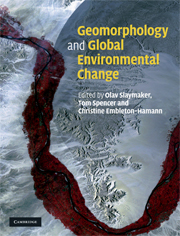Book contents
- Frontmatter
- Contents
- List of contributors
- Preface
- Acknowledgements
- List of acronyms and abbreviations
- 1 Landscape and landscape-scale processes as the unfilled niche in the global environmental change debate: an introduction
- 2 Mountains
- 3 Lakes and lake catchments
- 4 Rivers
- 5 Estuaries, coastal marshes, tidal flats and coastal dunes
- 6 Beaches, cliffs and deltas
- 7 Coral reefs
- 8 Tropical rainforests
- 9 Tropical savannas
- 10 Deserts
- 11 Mediterranean landscapes
- 12 Temperate forests and rangelands
- 13 Tundra and permafrost-dominated taiga
- 14 Ice sheets and ice caps
- 15 Landscape, landscape-scale processes and global environmental change: synthesis and new agendas for the twenty-first century
- Index
9 - Tropical savannas
Published online by Cambridge University Press: 05 July 2015
- Frontmatter
- Contents
- List of contributors
- Preface
- Acknowledgements
- List of acronyms and abbreviations
- 1 Landscape and landscape-scale processes as the unfilled niche in the global environmental change debate: an introduction
- 2 Mountains
- 3 Lakes and lake catchments
- 4 Rivers
- 5 Estuaries, coastal marshes, tidal flats and coastal dunes
- 6 Beaches, cliffs and deltas
- 7 Coral reefs
- 8 Tropical rainforests
- 9 Tropical savannas
- 10 Deserts
- 11 Mediterranean landscapes
- 12 Temperate forests and rangelands
- 13 Tundra and permafrost-dominated taiga
- 14 Ice sheets and ice caps
- 15 Landscape, landscape-scale processes and global environmental change: synthesis and new agendas for the twenty-first century
- Index
Summary
Introduction
Since our human lineage evolved in the open woodlands and grasslands of Africa, savanna landscape images may lie in our genetic memory and, indeed, may be subliminally familiar to us all. Certainly they are among the more wide-spread of the global zonal systems that are known as major biomes and their extent and diversity lends importance to the need to understand their possible responses to environmental change. Vast areas of the globe are characterised by seasonal tropical climates that support a characteristic range of landforms and geomorphological processes. ‘Savanna’ (alternatively savannah) is a word of Amerindian origin initially used in the sixteenth century to describe grasslands in the West Indian islands (Shorrocks, 2007). The term is now most frequently associated with extensive plains in the continental interiors of Africa, South America, India and Australia where there are abundant mixed tree and grass vegetation formations. Although in essence the word has an ecological or biogeographical meaning, the strong interrelationships between climate, vegetation, soils, geomorphology and even geology (Fig. 9.1) entail that it is applied to the description of landscapes in general and therefore has geomorphological meaning. The word is interpreted differently in different parts of the world and, because savannas are extraordinary repositories of both biological and geomorphological diversity – due in no small part to their widespread geographical nature – there is no simple or universally agreed definition. Nevertheless, common ecological elements of savannas would likely include a continuous C4 grass layer with varying proportions of C3 trees and shrubs, while geomorphologically they are characteristically associated with plains and inselbergs on deeply weathered surfaces. Given the seasonal nature of the rain- fall regime in these regions, fire is a consistent component of the natural environment and of considerable ecological and, through a complex of interactions, even geomorphological importance.
- Type
- Chapter
- Information
- Geomorphology and Global Environmental Change , pp. 248 - 275Publisher: Cambridge University PressPrint publication year: 2009
- 1
- Cited by



